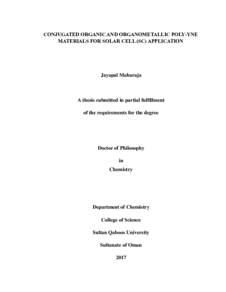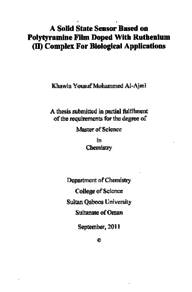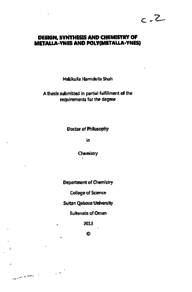وثيقة
Conjugated organic and organometallic poly-yne materials for solar cell (sc) application
الناشر
Sultan Qaboos University
ميلادي
2017
اللغة
الأنجليزية
الملخص الإنجليزي
A low band-gap poly-yne, Poly[1,4-dioctyloxyphenylene-2,5-diylethynylene-2,3-diphenylthieno[3,4-b]pyrazine-5,7-diyl)ethynylene] (P) comprising of alternative units of 2,3-diethynyl-5,7-diphenylthieno[3,4-b]pyrazine and 2,5-dioctyloxyphenylene has been synthesized and characterized. The p-type poly-yne P was then mechanically blended with n-type acceptor material N,N'-bis(1-ethylpropyl)-3,4:9,10-perylene bis(tetracarboxyldiimide) (PTCDI) for solar cell (SC) studies. A series of SCs were fabricated with varying blend ratio of P and PTCDI, and their SC performance has been evaluated. Effect of thermal annealing on a blend of P and PTCDI has also been tested. A fullerene-free SC with external quantum efficiency (EQE) of 5.5% has been achieved successfully for the blend of 10 P: 90 PTCDI. The structures of P and PTCDI have been optimized, and their HOMO and LUMO energy levels have been determined by the DFT calculation to complement the observed SC performance of the materials.
The poly(platina-ynes) (M1) incorporating 2-amino-1,4-phenylene spacer has been synthesized, and this p-type donor material M1 was then covalently linked to an n-type acceptor material, 4-fluoro-3,5-dinitrobenzoyl-o-quinodimethane[60] fullerene derivative (C60-DNF) to synthesize M2, where both D and A are present within the same material. The SC performance of the device made of M2 has been evaluated. In addition, SC performance of a mechanical blend of M1 and M2 with another fullerene derivative, C60-Me have been evaluated separately. To understand the energy transfer efficiency in SC performance of these materials, model dimeric complexes M3 and M4 were designed, and their structures have been optimized, and HOMO and LUMO energy levels have been determined by DFT calculation, which was then compared with M1 and M2.
New acetylide-functionalized non-fused and fused heteroarylethynylpyridine-based ligands (L = L1-L6) incorporated CuI clusters (C1-C6) have been synthesized via coordination driven self-assembly of CuI, L, and PPh3 (R1) in dichloromethane and completely characterized. The rhomboid dimeric structure (for C1, C2, C4, and C5) and polymeric structure (for C6) have been determined by single crystal X-ray crystallography. A series of related CuI clusters (C7-C13) bearing carboxylic acid (R2)/sulfonic acid anchored PPh3 (R3) have also been synthesized and employed as sensitizers for the DSSC application. Complexes C7-C13 displayed a moderate PCE in the range of 0.07% to 1.56%, and the highest performance has been obtained for C13 bearing ethynylterthienylpyridnyl ligand and PPh3-SO3H co-ligand. The structures of all complexes have been optimized, and their HOMO and LUMO energy levels have been determined by DFT calculation to complement the observed SC performance.
الوصف
Thesis
المجموعة
URL المصدر
الملخص العربي
تم تحضير ودراسة خواص البوليمر منخفض فرق الطاقة: بولي ] 1 ، 4 ثنائي أوكتايل فينيلين - - 2 ، 5 ثنائي ايثيلين- -2 ، 3 ثنائي فينيل ثينو] - 3 ، 4 ب[ بيرازين- - 5 ، 7 ثنائي آيل ايثيلين[ - (P) والمتكون من وحدات متبادلة من 2 ، 3 -ثنائي ايثيل5 ، 7 ثنائي فينيل ثينو ] - 3 ، 4 ب[ بيرازين و - 2 ، 5 ثنائي اوكتايل أوكسي فينيلين. ولدراسة خواص -الخلايا الشمسية تم دمج هذا البوليمر P من الفئة- P ميكانيكياً مع بوليمر مستقبل من الفئة- N : N ، N' ثنائي ) - 1 -إيثيل بروبيل( - 3 ، 4 : 9 ، 10 بيرلين ثنائي )رباعي كاربوكسيل ثنائي أميد( ) - - PTCDI (. مجموعة من الخلايا الشمسية المكونة من خليط من P و PTCDI بنسب متفاوتة تم تصميمها وتم تقييم أداءها كخلايا شمسية، كما تم اختبار تأثير التلدين الحراري على مزيج من P و PTCDI . وقد تم بنجاح الحصول على خلية شمسية بلا فوليرين بكفاءة خارجية (EQE) بنسبة 5.5% لمزيج من 10 P: 90 PTCDI . تم تحسين صيغ P و PTCDI وتحديد مستويات الطاقة HOMO و LUMO بواسطة حسابات DFT لتكملة الأداء الملحوظ للخلايا الشمسية للمواد. تم أيضاً تحضير بوليمر البلاتين (M1) المحتوي على المرتبطة )الليجند( 2 أمينو- - 1 ، 4 فينيلين وبعد ذلك تم دمج - هذا البوليمر من الفئة- P المانحة M1 بطريقة تساهمية مع مستقبل من الفئة- N : 4 فلورو- - 3 ، 5 ثنائي - نيتروبنزويل أورثو كينوثنائي ميثان ] - - 60 [ فوليرين ) C60-DNF ( لتحضير M2 ، مع تواجد كل من المانح Dوالمستقبل A في نفس المادة. كما تم تقييم أداء الخلايا الشمسية للجهاز المصنوع من البوليمر . M2 أيضاً تم دمج البوليمر M2 ميكانيكياً بنسب متفاوتة مع مشتق آخر من الفوليرين C60-Me وتقييم أداءه كخلية شمسية ومقارنته مع أنظمة مشابهة. تم تصميم نموذج لدايمر M3 و M4 بهدف توضيح كفاءة نقل الطاقة في أداء الخلايا الشمسية المكونة من هذه المواد. وقد تم تحديد صيغ المركبات الدايمرية ومستويات الطاقة HOMO و LUMO بواسطة حسابات DFT ، ومن ثم مقارنتها مع M1 و M2 . مركبات اسيتيلية جديدة مكونة من مرتبطات الآريل ايثيلين بيريدين (L = L1-L6) والمشتملة على CuI (C1-C6) تم تحضيرها عن طريق التناسق مدفوع التجمع الذاتي ل CuI و L و PPh3 (R1) في وجود ثنائي كلوروالميثان كمذيب وبعد ذلك تم دراسة خواص جميع المركبات الجديدة. الشكل المعيني للمركبات الدايميرية ) C1 و C2 و C4 و C5 ) والبوليمرية ) C6 ( تم تحديده باستخدام الأشعة السينية البلورية. تم أيضاً تحضير مجموعة أخرى ) C7-C13 ( ذات علاقة من مركبات CuI المحتوية على حمض كربوكسيلي (R2) / حمض السلفونيك و PPh3 (R3) وتم اختبارها لتطبيقاتDSSC. أظهرت المركبات C7-C13 قيمة PCE من 0.07% إلى 1.56% وأعلى أداء تم الحصول عليه للمركبC13 والمكون من المرتبطة )الليجند( ايثايل رباعي ثينايل بريدايل وحامض السلفونيك و PPh3 . وقد تم تحسين صيغ جميعالمركبات، وتحديد مستويات الطاقة HOMO و LUMO بواسطة حسابات DFT و TD-DFT لتكملة الأداء الملحوظ للخلايا الشمسية
قالب العنصر
الرسائل والأطروحات الجامعية



